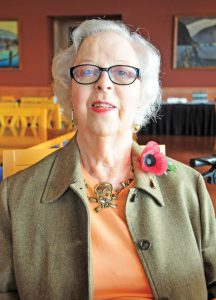Women’s Auxiliary Force Veteran tells stories with art
By Lookout on Nov 10, 2014 with Comments 0

Pattie Ashbaugh, Veteran of the Women’s Auxiliary Force (WAF),
For Pattie Ashbaugh, an 88-year-old London-born Victoria resident and veteran of the Women’s Auxiliary Force (WAF), life during the Second World War was spent mostly in secret office 60-feet below the surface.
As a “plotter” for the WAF, Ashbaugh tracked aerial bombardments and engagements across the theatre of war from Fighter Command, located underneath Bentley Priory in London, England.
“Every morning when we came into work we had to swear on the Bible that we would never reveal information about our work,” recalls Ashbaugh.
“There were other offices that plotted much smaller parts of the theatre, but ours was the only one that covered it all. It was a very exciting job for a 17-year-old girl.”
Ashbaugh’s job consisted of listening to radio transmissions from spotters across the country, and keeping track of V-1 flying bombs, called “buzz bombs”, and flights of both Allied and Axis aerial units.
“We’d get information from anyone, from boy scouts on the roof with binoculars, to old men in their yards with a telescope,” says Ashbaugh.
“Then we’d use different coloured figures to mark where they were on the map, which would be entered into the records and used by command, and when the clock turned over we’d wipe it off and start all over again. It was very hectic. Eventually it became automatic, but if you weren’t paying attention everything would happen so quickly you’d miss it.”
The Flight Command was the central command for all Allied aerial units during the war, and as such was home to some influential figures.
Among commanders from all Allied countries, then Prime Minister Winston Churchill kept an office at Flight Command, though a teenaged Ashbaugh wasn’t impressed.
“He wasn’t very interesting to a teenage girl,” she says.
“We would always be wearing his Siren Suit (a type of jumpsuit created by Churchill in the 30s, which became standard issue throughout the war), and he’d be up in the balcony where all the offices were. We didn’t have time to see what he was up to, we were much too busy.”
According the Ashbaugh the nightlife of wartime London was surprisingly active.
“There were clubs across town that were free for serving men and women. You would show up and sit down, and you never knew who was playing that night,” she says.
“One time my girlfriends and I went out for a show and who should come out but Major Glenn Miller. He leaned over the stage and sang right to us. I’ll never forget that.”
Every night the pubs were packed with serving men and women trying to forget the terror and tragedy of the day’s work.
Ashbaugh met her husband Fred, a Royal Canadian Air Force (RCAF) bomber captain and recipient of the Distinguished Flying Cross, at one such pub.
Their first meeting went anything but smoothly.
“I wrote my phone number on a 10 pound note, and he accidently spent it at the pub,” she says, laughing. “He had a hell of a time getting it back. I think a few other people must have seen the number because I got more than a few phone calls after that.”
Though the war was a terrible time, Ashbaugh says those years were also the most exciting times of her life.
“It’s difficult, because every day horrible things are happening, friends and family are dying, but you don’t have time to grieve them,” she says. “When they say it was the best of times and it was the worst of times, they’re right.”
Following the war, Ashbaugh worked through complex emotions left over from the conflict using the medium of painting. Completing a portrait of her two eldest brothers, both merchant navy sailors lost during the war, as well as a picture of the Flight Command office, Ashbaugh says she was able to free herself of unexpressed emotions.
“It was very cathartic. I never felt like I’d had enough time to grieve for my brothers, we were too busy,” she says. “Once I painted them I got it all out. I could move on. It was very important to me.”
The portrait of Flight Command was delivered to the National War Museum in Ottawa, where it is currently in display rotation.
Now living in Victoria with her husband, with three grown daughters, grandchildren, and even some great grandchildren, Ashbaugh spends her days watching the waters of the Gorge from her balcony with Fred, having lunch at the Wardroom, and painting.
“We stay social, but we’d been very busy for a very long time,” she says. “Now it’s just time to relax.”
Shawn O’Hara – Staff Writer
Filed Under: Top Stories
About the Author:





